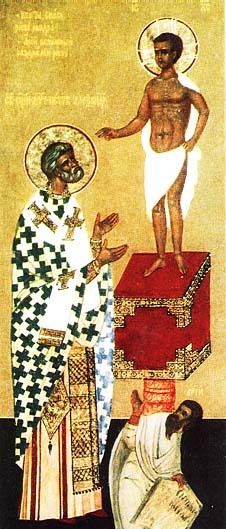Silvanus of Gaza | |
|---|---|
| Hieromartyr | |
| Born | Syria Palaestina |
| Died | ca. 311 AD Phaeno |
| Venerated in | Oriental Orthodox Church Eastern Orthodox Church Roman Catholic Church |
| Canonized | Pre-Congregation |
| Feast | May 4 |
Silvanus of Gaza, also Hieromartyr Silvanus of Gaza was bishop of Gaza and a martyr during the Great Persecution, together with 39 other Christians. He is venerated as a saint by the Roman Catholic and the Eastern Orthodox Church and his feast day is the 4 May and the 14 October, respectively. [1] [2]
Silvanus was most likely born and raised in Gaza. [2] Little is known of his life, but he seems to have been a soldier during his young manhood before he became a priest. [3] He then became known for his life of exemplary rectitude and piety and was therefore made presbyter of the Gazan church.
During the Diocletian Persecution he was condemned to work as a slave in the copper mines of Phaeno. By that time he was already old and soon weakened under the atrocious work in the mines, making him incapable of continue to work though he encouraged his fellow Christians to remain strong in their faith. When it was decided that those who were incapable of working in the mines were to be killed, Silvanus and 39 other Christians were martyred. [3] Silvanus was beheaded and was known as hieromartyr as he had become bishop of Gaza.

Pope Marcellinus was the bishop of Rome from 30 June 296 to his death in 304. A historical accusation was levelled at him by some sources to the effect that he might have renounced Christianity during Emperor Diocletian's persecution of Christians before repenting afterwards, which would explain why he is omitted from lists of martyrs. The accusation is rejected, among others, by Augustine of Hippo. He is today venerated as a saint in the Catholic Church and in the Serbian Orthodox Church.

May 3 - Eastern Orthodox Church calendar - May 5

June 4 - Eastern Orthodox Church calendar - June 6

Saint Victorinus of Pettau was an Early Christian ecclesiastical writer who flourished about 270, and who was martyred during the persecutions of Emperor Diocletian. A Bishop of Poetovio in Pannonia, Victorinus is also known as Victorinus Petavionensis or Poetovionensis. Victorinus composed commentaries on various texts within the Christians' Holy Scriptures.

Anthimus of Nicomedia, was the bishop of Nicomedia in Bithynia, where he was beheaded during a persecution of Christians, traditionally placed under Diocletian, in which "rivers of blood" flowed.

January 1 - Eastern Orthodox liturgical calendar - January 3

January 10 - Eastern Orthodox liturgical calendar - January 12

January 28 - Eastern Orthodox liturgical calendar - January 30

Saints Cyprian and Justina are honored in the Catholic Church, Eastern Orthodox Church and Oriental Orthodoxy as Christians of Antioch, who in 304, during the Diocletianic Persecution, suffered martyrdom at Nicomedia on September 26. According to Roman Catholic sources, no Bishop of Antioch bore the name of Cyprian.
Sabinus of Hermopolis was a procurator, possibly bishop, and Christian martyr of Hermopolis in Egypt.

August 27 - Eastern Orthodox liturgical calendar - August 29
Astius is a 2nd-century Christian martyr venerated by the Roman Catholic and Eastern Orthodox churches. He was the bishop of Dyrrhachium.

Pope Peter I of Alexandria was the 17th Pope and Patriarch of Alexandria. He is revered as a saint by the Coptic Orthodox Church, the Eastern Orthodox Church, and the Catholic Church.

December 21 - Eastern Orthodox liturgical calendar - December 23

August 20 - Eastern Orthodox liturgical calendar - August 22

October 29 - Eastern Orthodox liturgical calendar - October 31

December 4 - Eastern Orthodox liturgical calendar - December 6

December 9 - Eastern Orthodox liturgical calendar - December 11

December 22 - Eastern Orthodox liturgical calendar - December 24
The Diocese of Gaza was a bishopric in the Holy Land. Its episcopal see was the city of Gaza and it is now a vacant Latin Catholic titular see.